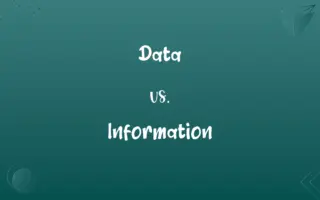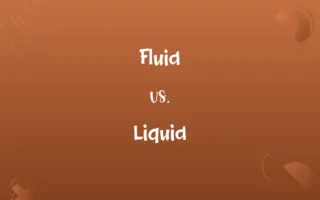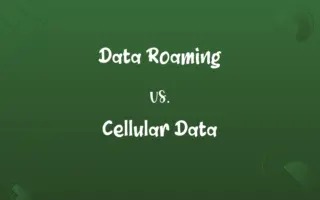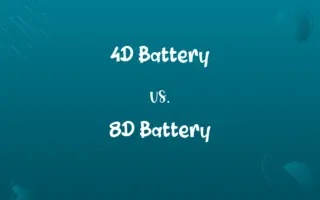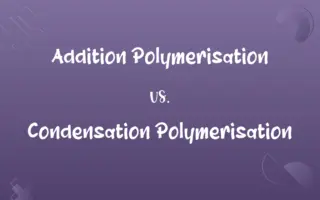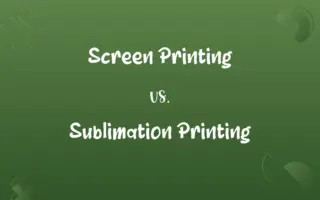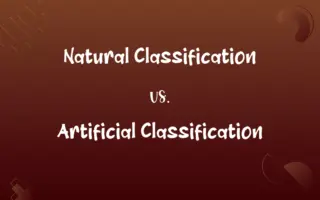Fluorescence Microscopy vs. Confocal Microscopy: Know the Difference

By Shumaila Saeed || Updated on December 25, 2023
Fluorescence microscopy uses fluorescent stains to visualize samples, whereas confocal microscopy adds a spatial filtering technique to enhance clarity and detail.

Key Differences
Fluorescence microscopy involves labeling samples with fluorescent dyes and illuminating them with specific wavelengths of light, causing the dyes to emit light and reveal cellular structures. Confocal microscopy, a subtype of fluorescence microscopy, employs a pinhole to eliminate out-of-focus light, thus providing sharper images.
Shumaila Saeed
Dec 09, 2023
In fluorescence microscopy, the entire sample is illuminated simultaneously, which can lead to background fluorescence and reduced image clarity. Confocal microscopy, however, uses point illumination and a spatial pinhole to block out-of-focus light, enhancing image resolution and contrast.
Shumaila Saeed
Dec 09, 2023
Fluorescence microscopy is widely used for its simplicity and effectiveness in visualizing specific components within cells. Confocal microscopy, on the other hand, allows for the construction of three-dimensional images from sequential optical sections, offering more detailed insights into the sample.
Shumaila Saeed
Dec 09, 2023
The equipment required for fluorescence microscopy is generally less complex and more affordable compared to confocal microscopy, which requires additional components like laser sources and sophisticated detection systems.
Shumaila Saeed
Dec 09, 2023
While fluorescence microscopy is suitable for a wide range of biological applications, confocal microscopy is particularly beneficial in cases where detailed, three-dimensional imaging is necessary, such as in developmental biology and neurology.
Shumaila Saeed
Dec 09, 2023
ADVERTISEMENT
Comparison Chart
Illumination Method
Whole sample illuminated
Point illumination with spatial filtering
Shumaila Saeed
Dec 09, 2023
Image Clarity
Can have background fluorescence
Sharper, with reduced background
Shumaila Saeed
Dec 09, 2023
Typical Applications
Broad range in biology
Focused on detailed structural studies
Shumaila Saeed
Dec 09, 2023
ADVERTISEMENT
Fluorescence Microscopy and Confocal Microscopy Definitions
Fluorescence Microscopy
Fluorescence microscopy visualizes samples using fluorescent dyes under specific light wavelengths.
Scientists used fluorescence microscopy to observe the distribution of proteins within cells.
Shumaila Saeed
Dec 01, 2023
Confocal Microscopy
This method is particularly effective for 3D reconstruction of thick specimens.
Researchers used confocal microscopy to create a three-dimensional model of the organoid.
Shumaila Saeed
Dec 01, 2023
Fluorescence Microscopy
This technique is used to study properties like the location of specific biomolecules.
Fluorescence microscopy helped identify the cellular localization of the newly discovered receptor.
Shumaila Saeed
Dec 01, 2023
Confocal Microscopy
It is widely used in fields requiring detailed, high-resolution cellular imaging.
Confocal microscopy played a key role in the study of cellular interactions in immune response.
Shumaila Saeed
Dec 01, 2023
Fluorescence Microscopy
It involves exciting fluorescent molecules in a specimen, causing them to emit observable light.
Fluorescence microscopy revealed the intricate network of neurons in the brain sample.
Shumaila Saeed
Dec 01, 2023
ADVERTISEMENT
Confocal Microscopy
It employs a pinhole to eliminate out-of-focus light, enhancing image depth and clarity.
The confocal microscopy technique allowed for clearer visualization of the tissue layers.
Shumaila Saeed
Dec 01, 2023
Fluorescence Microscopy
It offers high specificity by targeting and illuminating only the tagged components in a cell.
Using fluorescence microscopy, researchers tracked the movement of labeled DNA molecules.
Shumaila Saeed
Dec 01, 2023
Confocal Microscopy
Confocal microscopy is an advanced form of fluorescence microscopy providing sharper, more detailed images.
Confocal microscopy was crucial in obtaining high-resolution images of the synaptic connections.
Shumaila Saeed
Dec 01, 2023
Fluorescence Microscopy
Fluorescence microscopy enhances contrast in biological specimens, improving structural visualization.
The team used fluorescence microscopy to differentiate between healthy and cancerous cells.
Shumaila Saeed
Dec 01, 2023
Confocal Microscopy
Confocal microscopy involves scanning a sample point-by-point with a focused laser beam.
The intricate details of the cell’s interior were revealed through confocal microscopy scanning.
Shumaila Saeed
Dec 01, 2023
Repeatedly Asked Queries
Is confocal microscopy more expensive than fluorescence microscopy?
Yes, confocal microscopy typically requires more sophisticated and costly equipment.
Shumaila Saeed
Dec 09, 2023
How does confocal microscopy differ from traditional fluorescence microscopy?
Confocal microscopy employs a pinhole and point illumination to reduce out-of-focus light, providing sharper and more detailed images.
Shumaila Saeed
Dec 09, 2023
Can fluorescence microscopy create 3D images?
While it has limited 3D capabilities, confocal microscopy is better suited for detailed three-dimensional imaging.
Shumaila Saeed
Dec 09, 2023
What are common applications of fluorescence microscopy?
It's widely used in biology for visualizing cells, tissues, and specific molecular structures.
Shumaila Saeed
Dec 09, 2023
What is fluorescence microscopy?
Fluorescence microscopy is a technique that uses fluorescent dyes to visualize and study biological specimens under specific light wavelengths.
Shumaila Saeed
Dec 09, 2023
Are there limitations to using fluorescence microscopy?
Yes, it can result in background fluorescence and has limitations in imaging thick specimens.
Shumaila Saeed
Dec 09, 2023
What kind of samples can be studied with confocal microscopy?
It's suitable for a variety of biological specimens, especially those requiring detailed structural analysis.
Shumaila Saeed
Dec 09, 2023
How does fluorescence microscopy contribute to medical research?
It enables the study of cellular processes and molecular interactions, aiding in disease understanding and drug development.
Shumaila Saeed
Dec 09, 2023
What safety precautions are needed for fluorescence microscopy?
Proper handling of fluorescent dyes and protection from intense light sources are essential.
Shumaila Saeed
Dec 09, 2023
What are the challenges in using confocal microscopy?
Challenges include handling complex equipment, data analysis, and maintaining sample integrity during imaging.
Shumaila Saeed
Dec 09, 2023
How does the pinhole in confocal microscopy improve image quality?
The pinhole blocks out-of-focus light, thereby enhancing image sharpness and contrast.
Shumaila Saeed
Dec 09, 2023
What is the role of lasers in confocal microscopy?
Lasers provide the focused light source necessary for scanning the specimen in confocal microscopy.
Shumaila Saeed
Dec 09, 2023
Can fluorescence microscopy be combined with other imaging techniques?
Yes, it's often combined with other methods like electron microscopy for comprehensive analysis.
Shumaila Saeed
Dec 09, 2023
Why is confocal microscopy important in scientific research?
It provides high-resolution, three-dimensional images crucial for detailed structural and functional studies in biology.
Shumaila Saeed
Dec 09, 2023
Can fluorescence microscopy differentiate between different cell components?
Yes, by using different fluorescent dyes, it can specifically target and visualize various cellular components.
Shumaila Saeed
Dec 09, 2023
Is training required to operate confocal microscopes?
Yes, due to their complexity, proper training is necessary for using confocal microscopes effectively.
Shumaila Saeed
Dec 09, 2023
Can confocal microscopy be used for live-cell imaging?
Yes, it is particularly useful for observing live cells in real-time with high resolution.
Shumaila Saeed
Dec 09, 2023
What advancements have been made in confocal microscopy technology?
Recent advancements include improved laser technology, faster scanning capabilities, and enhanced software for image analysis.
Shumaila Saeed
Dec 09, 2023
How does fluorescence microscopy aid in genetic research?
It helps in visualizing and tracking gene expression and chromosomal locations in cells.
Shumaila Saeed
Dec 09, 2023
Can both techniques be used for quantitative analysis?
Yes, both can be employed for quantitative measurements such as intensity, distribution, and co-localization of molecules.
Shumaila Saeed
Dec 09, 2023
Share this page
Link for your blog / website
HTML
Link to share via messenger
About Author
Written by
Shumaila SaeedShumaila Saeed, an expert content creator with 6 years of experience, specializes in distilling complex topics into easily digestible comparisons, shining a light on the nuances that both inform and educate readers with clarity and accuracy.















